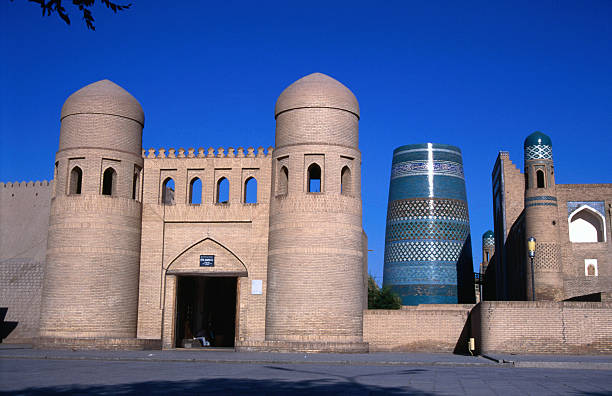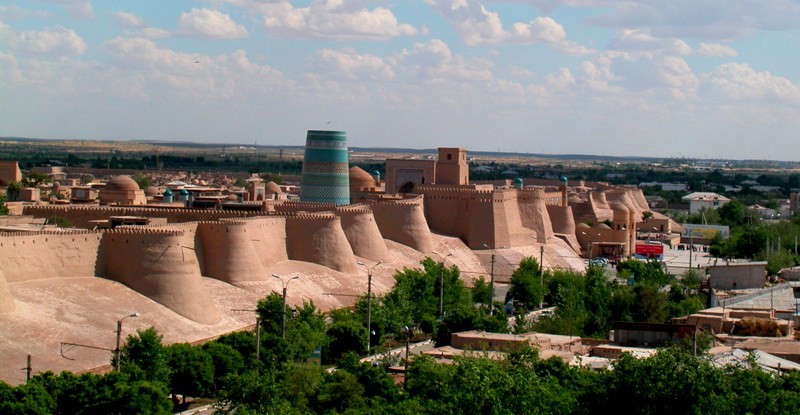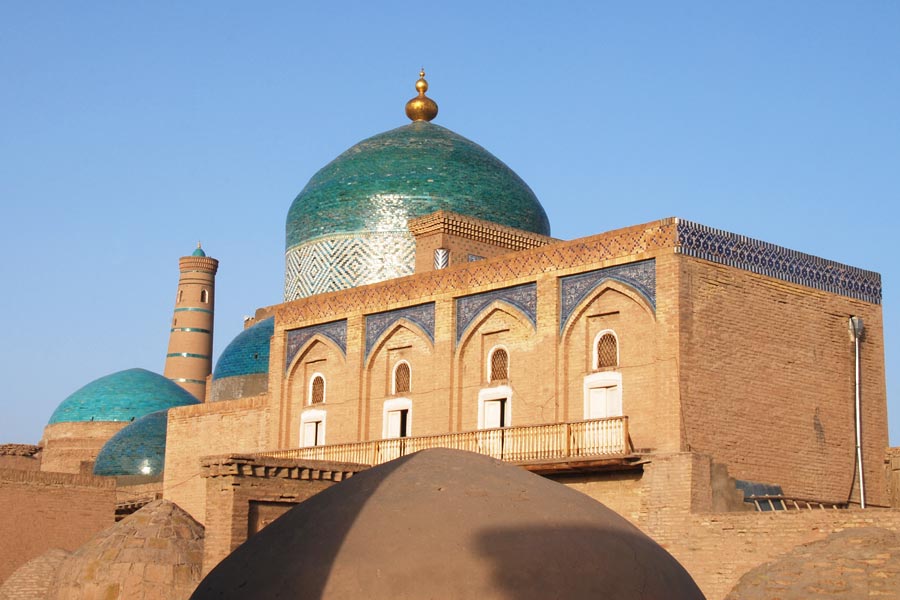Khiva is one of the most remote of Central Asia’s Great Silk Road cities, a fascinating desert town, preserved in its entirety since medieval times. Khiva oasis, which lies south of the Amu Darya river, was the final stop for caravans before crossing the desert to Persia.
Archaeological excavations prove the age of Khiva to be 2,500 years old. All these facts have enabled UNESCO to proclaim Khiva a city-reserve, and its inner part Ichan-Kala has been recognized as a historical monument of world significance.
Kalta-Minor Minaret. In Khiva, there are up to 50 mosques and almost as many minarets. These towers, creating a fanciful and scenic townscape, seem to step into modern life directly from the Middle Ages. The most extraordinary among them, at least in respect to its shape, is Kalta-Minor minaret, or short tower.
In the middle of the 19th century, the ambitious ruler Muhammad-Aminkhan conceived the idea of building the biggest madrasah with an adjoining minaret, which had to be the tallest tower not only in Khiva, but in the whole of Central Asia. It had to achieve 230 feet in height. It must be said that by that time, many minarets had exceeded the dimensions practical for such kinds of constructions.

Khiva, Khorezm, Uzbekistan, Central Asia, Asia
Islam-Hojja Madrasah and Minaret. Islam Hojja Madrasah and Minaret is a peculiar architectural complex. The madrasah features a large domed hall and 42 hujras rooms for students. Next to the madrasah is Uzbekistan’s highest minaret. The history preserved the name of its architect, Usto Khudaibergen Hojji.
Islam Hojja Minaret is a huge brick tower, circular in section. Being over 183 feet in height, it surpasses the Kalyan minaret in Bukhara. The perimeter of its base is almost 40 feet. The minaret considerably tapers to the top, which makes it look slender and strong. The minaret tower is crowned with an open-work lantern with a graceful cornice and a small dome with a golden top. The minaret trunk is beautifully decorated with ornamental white and blue glazed ceramic bands alternating with a figured setting of polished bricks. Islam Hojja Minaret is a point of pride for Khiva citizens. It dominates Khiva and is visible everywhere in the ancient city, making it difficult for a tourist to be lost.
Kunya-Ark Citadel. Kunya-Ark Citadel (Old Citadel) abuts Khiva’s fortification wall next to Ata-Darvoza gate. The citadel is the oldest remaining khan’s residence in Khiva. It occupies a large area by the western wall of Ichan-Kala or Inner Town. The citadel was built in 1686 by order of Arang-Khan, and accommodated various fortifications, a gunpowder factory, an arsenal, a khan’s palace, a court, and other structures.
The citadel was built not on an empty piece of land; it evidently stands on the ruins of earlier structures. The archeological excavations carried out in the territory of the citadel revealed a block of dwelling houses and craftsmen’s shops with remains of ceramics and coins of the 13th-15th centuries.
Muhammad Rakhimkhan Madrasah. To the east of the square that lies at the foot of Kunya-Ark Citadel, there stands Muhammad Rakhimkhan Madrasah. Khan Muhammad Rakhim II was known as an enlightened monarch, and he supported poets and scholars. He himself composed poetry under the pen-name Firuz. Under his patronage, traditional education was reformed, which resulted in the opening of a new type of school where not only Arabic and the Koran were taught, but also secular subjects as well.
During the reign of the khan several palaces, mosques and madrasahs were built in Khiva. But of utmost importance for Muhammad Rakhimkhan was the construction of a big madrasah, which later bore the name of the khan himself. Completed in 1874, this structure has an unusual layout. From the street the entrance leads to the yard enclosed from outside by a continuous wall and from inside surrounded by one-floor hujra cells.
Walls and Gates of Khiva. Though Khiva is about 2,500 years old, it acquired its present appearance in the 18th-early 20th centuries. Khiva consists of two urban parts: the inner town Ichan-Kala and the outer town Dishan-Kala. From the very beginning the core of the city, Ichan-Kala, rectangular in plan, was enclosed in fortification walls.
For centuries these walls served ideally the purpose of the town’s defense. But in 1220, they were destroyed by Mongol invaders and later, the gentle slopes of the collapsed walls were used for burying the dead. In 1790, the wall was rebuilt by order of Khiva’s khan Muhammad-Amin-Inak. It was over 3,900 feet long, 23 feet high and about 20 feet thick at the base. Since Khiva stood at an important intersection of the Great Silk Road, there were built four monumental gates directing north, south, east and west. Ark-Darvoza gate, located next to Kunya-Ark Citadel, let in the caravans from the west. Kosh-Darvoza (“Double Gate”) with two entrance arches faced south. Tash-Darvoza (“Stone Gate”) was built in the northern part of the city.

The most remarkable is the eastern gate Palvan-Darvoza (“Hero Warrior’s Gate”), through which ran the road to the Amu Darya River and to the ancient trade town Khazarasp. The surviving marble slab above the arch of the gate shows the date the construction was completed 1806. Adjoining the gate is the gallery with six domes, and a shopping arcade. Soon after the gate had been built, near it there appeared Allakuli-Khan Madrasah, a caravanserai, and a tim domed trading center.
Kutlug Murad Inak Madrasah. Among 20 Khiva’s madrasahs that have been preserved to the present day, Kutlug Murad Inak Madrasah is the oldest. Every Khiva’s ruler tried to inscribe his name upon the pages of history by building not only palaces and caravanserais, but also mosques and madrasahs. Kutlug Murad Inak Madrasah was built in 1809, during the reign of Khan Muhammad Rakhim I. That was the time when extensive construction activities started in the capital of Khiva Khanate, which at that time was consolidating its position in the region.
During the next decades, a shopping arcade, caravanserai, bathhouses and Tash-Khauli Palace in this part of Ichan-Kala were built. Eventually, Kutlug Murad Inak Madrasah initiated the construction of an architectural ensemble at Palvan-Darvoza Gate.
Kibla Tozabog – Khiva Khan’s summer residence. In Khiva, time has spared about 50 ancient madrasahs and just a few khans’ palaces. All of them are of certain interest since they vividly show the architectural tendencies characteristic of Khorezm over several centuries. It was Khan Muhammad Rakhim II, “a poet on the throne,” known in Uzbek Literature as Firuz, who initiated the construction of the Kibla Tozabog summer residence with its orchards and flower gardens.
The complex is an amazing combination of traditional Khiva architecture that took shape in the Middle Ages, and new European architectural techniques. A typical hauli country estate of a rich Khiva resident became the prototype of Kibla Tozabog. Such an estate looks like a small fort. Even today, these hauli estates can be found in the suburbs of Khiva and Urgench.
Pahlavan Mahmud Complex. Near Juma Mosque, inside a labyrinth of narrow streets, there towers a large turquoise dome with a kuba golden ball. This is the dome of Pahlavan Mahmud Mausoleum.
The people have always honoured pahlavans, or strong men. Pahlavan Mahmud from Khorezm was the one who was given such an honour. He was a furrier by trade, a Hercules by build, a philosopher by spirit, and a poet by vocation. In general, he was a man of many gifts, like many other great figures of the Renaissance.

In his lifetime, Pahlavan Mahmud became recognized and famous both in Khiva Khanate and far beyond. After his death, people began to revere him as a peer; a patron saint of Khiva. His plain grave became a shrine. According to legend, the poet was buried in the workshop near his home. The memorial complex that can be seen there today was built in the 19th century. Some fragments of adobe brickwork of the earliest mausoleum still remain inside the walls of the mausoleum built in 1810. Later, the interior and exterior walls of the mausoleum were covered with beautiful majolica.


